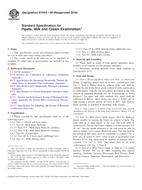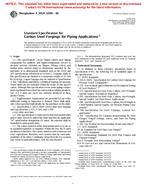1.1 This specification covers the requirements for electrodeposited tin-lead coatings on fabricated articles of iron, steel, copper, and copper alloys, to protect them against corrosion (Note 1), to improve and preserve solderability over long periods of storage, and to improve anti-galling characteristics.
Note 1-Some corrosion of tin-lead coatings may be expected in outdoor exposure. In normal indoor exposure, tin-lead is protective on iron, copper, and copper alloys. Corrosion may be expected at discontinuities (pits or pores) in the coating. Porosity decreases as the thickness is increased. A primary use of the tin-lead coating (solder) is with the printed circuit industry as a solderable coating and as an etch mask material.
1.2 This specification applies to electrodeposited coatings containing a minimum of 50% and a maximum of 70% tin. The specification applies to mat, bright, and flow-brightened tin-lead coatings.
Note 2-Tin-lead plating baths are composed of tin and lead fluoborates and of addition agents to promote stability. The final appearance may be influenced by the addition of proprietary brighteners. Without brighteners, the coatings are mat; with brighteners, they are semibright or bright. Flow-brightened coatings are obtained by heating mat coatings to above the melting point of tin-lead for a few seconds and then quenching; palm oil, hydrogenated oils, or fats are used as a heat-transfer medium at a temperature of 260 + 10°C (500 + 20°F), but other methods of heating are also in use. The maximum thickness for flow-brightening is about 7.5 [mu]m (0.3 mil); thicker coatings tend to reflow unevenly. The shape of the part is also a factor; flat surfaces tend to reflow more unevenly than wires or rounded shapes (Note 3). Note 3-Volatile impurities in tin-lead coatings will cause bubbling and foaming during flow-brightening resulting in voids and roughness. The impurities can arise from plating solution addition agents and from improper rinsing and processing.
1.3 This specification does not apply to sheet, strip, or wire in the unfabricated form or to threaded articles having basic major diameters up to and including 19 mm (0.75 in.).
Product Details
- Published:
- 04/01/2004
- Number of Pages:
- 5
- File Size:
- 1 file , 44 KB


